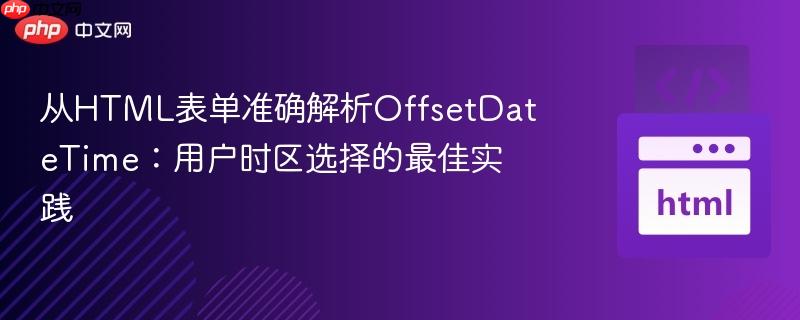
现代web应用中,用户经常需要输入特定事件的日期和时间。在java等后端语言中,java.time.offsetdatetime是一个强大的类型,用于精确表示带有时区偏移的瞬时时间点。然而,html表单提供的日期时间输入类型,如<input type="datetime-local">或分别使用<input type="date">和<input type="time">,都只捕获本地日期和时间信息,而不包含任何时区偏移信息。
这意味着,如果一个位于东京的用户输入了“2023年10月27日 10:00”,服务器在没有额外时区信息的情况下,会将其解释为服务器所在时区的“2023年10月27日 10:00”。这显然会导致数据不准确,尤其当事件的实际发生地与用户或服务器的时区不同时。例如,用户可能在东京,但她正在安排一个将在纽约发生的会议。仅仅知道本地时间是不足以确定全球范围内的准确时间点的。
尝试从浏览器获取时区偏移或根据用户IP地址推断时区,虽然看似便捷,但存在严重缺陷:
最可靠且专业的解决方案是引导用户明确选择事件发生的时区。这不仅解决了技术难题,也确保了用户意图的准确传达。
时区应以标准化的Continent/Region格式命名,例如Europe/Paris、America/New_York或Asia/Tokyo。这种命名方式是全球公认的,并且能够正确处理夏令时等复杂情况。
立即学习“前端免费学习笔记(深入)”;
为了提供良好的用户体验,可以设计一个分层的时区选择器:
这种方式既能帮助用户快速定位,又避免了冗长的下拉列表。
在后端,当用户提交了所选的大洲和地区后,可以将其组合成完整的时区ID,并创建java.time.ZoneId对象。
示例代码:
import java.time.DateTimeException;
import java.time.ZoneId;
import java.time.zone.ZoneRulesException;
import java.util.Set;
public class TimeZoneProcessor {
public static ZoneId createZoneIdFromUserSelection(String userSelectedContinent, String userSelectedRegion) {
if (userSelectedContinent == null || userSelectedContinent.trim().isEmpty() ||
userSelectedRegion == null || userSelectedRegion.trim().isEmpty()) {
throw new IllegalArgumentException("Continent and region cannot be empty.");
}
String zoneName = String.join("/", userSelectedContinent, userSelectedRegion);
ZoneId zoneId = null;
try {
zoneId = ZoneId.of(zoneName);
System.out.println("Successfully created ZoneId: " + zoneId);
} catch (DateTimeException e) {
// ZoneId.of() can throw DateTimeException if the ID is invalid
System.err.println("Invalid time zone ID format or unknown ID: " + zoneName + ". Error: " + e.getMessage());
// Depending on your application, you might re-throw, log, or return a default.
throw new IllegalArgumentException("Invalid time zone selection.", e);
} catch (ZoneRulesException e) {
// ZoneRulesException is a subclass of DateTimeException, but explicitly catching it can be useful
System.err.println("No rules found for time zone ID: " + zoneName + ". Error: " + e.getMessage());
throw new IllegalArgumentException("No time zone rules found for selection.", e);
}
return zoneId;
}
public static void main(String[] args) {
// Example usage:
String continent1 = "Europe";
String region1 = "Paris";
ZoneId parisZone = createZoneIdFromUserSelection(continent1, region1); // Europe/Paris
String continent2 = "America";
String region2 = "Chicago";
ZoneId chicagoZone = createZoneIdFromUserSelection(continent2, region2); // America/Chicago
// Invalid example
try {
createZoneIdFromUserSelection("InvalidContinent", "InvalidRegion");
} catch (IllegalArgumentException e) {
System.out.println("Handled expected error: " + e.getMessage());
}
// Listing available time zones (for frontend population)
System.out.println("\n--- Available Time Zones (Example Subset) ---");
Set<String> availableZoneIds = ZoneId.getAvailableZoneIds();
availableZoneIds.stream()
.filter(id -> id.startsWith("Asia/") || id.startsWith("Europe/"))
.limit(10)
.forEach(System.out::println);
}
}代码说明:
一旦从表单获取了本地日期时间字符串(例如,来自datetime-local的"2023-10-27T10:00")和用户选择的ZoneId,就可以将其转换为ZonedDateTime,进而转换为OffsetDateTime。
示例代码:
import java.time.LocalDateTime;
import java.time.ZonedDateTime;
import java.time.OffsetDateTime;
import java.time.ZoneId;
import java.time.format.DateTimeFormatter;
public class EventDateTimeConverter {
public static OffsetDateTime convertToOffsetDateTime(String localDateTimeString, ZoneId eventZoneId) {
// 1. 解析本地日期时间字符串
// 假设 localDateTimeString 格式为 "YYYY-MM-DDTHH:MM" (如 "2023-10-27T10:00")
LocalDateTime localDateTime = LocalDateTime.parse(localDateTimeString, DateTimeFormatter.ISO_LOCAL_DATE_TIME);
// 2. 将本地日期时间与用户指定的时区结合,创建 ZonedDateTime
ZonedDateTime zonedDateTime = localDateTime.atZone(eventZoneId);
// 3. 转换为 OffsetDateTime
OffsetDateTime offsetDateTime = zonedDateTime.toOffsetDateTime();
return offsetDateTime;
}
public static void main(String[] args) {
// 模拟从表单获取的数据
String formLocalDateTime = "2023-10-27T10:00"; // 用户输入的本地日期时间
String userSelectedContinent = "America";
String userSelectedRegion = "Chicago";
// 1. 获取用户指定的 ZoneId
ZoneId eventZoneId = TimeZoneProcessor.createZoneIdFromUserSelection(userSelectedContinent, userSelectedRegion);
// 2. 转换为 OffsetDateTime
OffsetDateTime finalOffsetDateTime = convertToOffsetDateTime(formLocalDateTime, eventZoneId);
System.out.println("用户输入的本地日期时间: " + formLocalDateTime);
System.out.println("用户指定的时区: " + eventZoneId);
System.out.println("最终的 OffsetDateTime: " + finalOffsetDateTime);
System.out.println("其UTC时间: " + finalOffsetDateTime.toInstant());
// 另一个例子:东京时间
String formLocalDateTimeTokyo = "2023-10-27T10:00";
ZoneId tokyoZone = TimeZoneProcessor.createZoneIdFromUserSelection("Asia", "Tokyo");
OffsetDateTime finalOffsetDateTimeTokyo = convertToOffsetDateTime(formLocalDateTimeTokyo, tokyoZone);
System.out.println("\n用户输入的本地日期时间 (东京): " + formLocalDateTimeTokyo);
System.out.println("用户指定的时区 (东京): " + tokyoZone);
System.out.println("最终的 OffsetDateTime (东京): " + finalOffsetDateTimeTokyo);
System.out.println("其UTC时间 (东京): " + finalOffsetDateTimeTokyo.toInstant());
}
}输出示例:
Successfully created ZoneId: America/Chicago 用户输入的本地日期时间: 2023-10-27T10:00 用户指定的时区: America/Chicago 最终的 OffsetDateTime: 2023-10-27T10:00-05:00 其UTC时间: 2023-10-27T15:00:00Z Successfully created ZoneId: Asia/Tokyo 用户输入的本地日期时间 (东京): 2023-10-27T10:00 用户指定的时区 (东京): Asia/Tokyo 最终的 OffsetDateTime (东京): 2023-10-27T10:00+09:00 其UTC时间 (东京): 2023-10-27T01:00:00Z
从输出可以看出,尽管两个事件都发生在各自时区的“10:00”,但由于时区不同,它们对应的UTC时间点是不同的,这正是OffsetDateTime的价值所在。
从HTML表单中准确解析OffsetDateTime并捕获用户意图的关键在于明确询问用户事件发生的时区。通过提供一个标准化的、分层的时区选择器,并结合Java java.time API进行后端处理,可以有效避免时区混淆问题,确保应用程序中日期时间数据的准确性和一致性。这种方法虽然增加了少量的用户交互,但对于需要精确时间管理的应用来说,是不可或缺的最佳实践。
以上就是从HTML表单准确解析OffsetDateTime:用户时区选择的最佳实践的详细内容,更多请关注php中文网其它相关文章!

HTML怎么学习?HTML怎么入门?HTML在哪学?HTML怎么学才快?不用担心,这里为大家提供了HTML速学教程(入门课程),有需要的小伙伴保存下载就能学习啦!

Copyright 2014-2025 https://www.php.cn/ All Rights Reserved | php.cn | 湘ICP备2023035733号